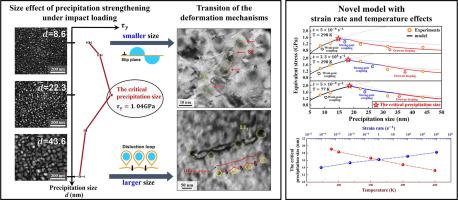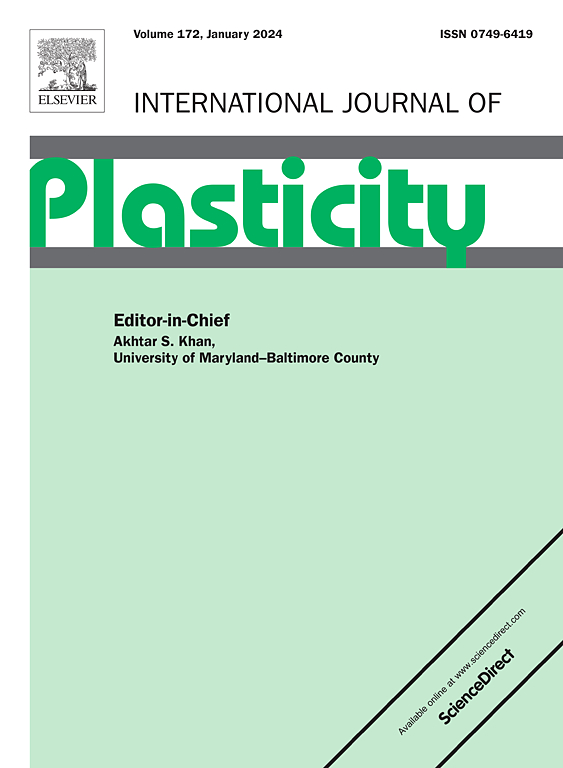Strain-rate and temperature dependent optimum precipitation sizes for strengthening in medium-entropy alloys
IF 9.4
1区 材料科学
Q1 ENGINEERING, MECHANICAL
引用次数: 0
Abstract
The (FeCoNi)86Al7Ti7 medium-entropy alloy (MEA) with varying sizes and fixed volume fraction of coherent L12 precipitates was fabricated, and the effects of precipitation size on mechanical properties at varying strain rates and temperatures were investigated experimentally. An optimum precipitation size for precipitation strengthening can be always observed for the experimental curves under different strain rates and temperatures. The dominant precipitation mechanism under dynamic conditions is found to be transited from the dislocation-shearing mechanism to the Orowan dislocation-looping mechanism with increasing precipitation size. A novel theoretical model was developed to consider the effects of strain rate and temperature on the precipitation shearing strengthening and the Orowan looping strengthening. The predicted precipitation strengthening curves as a function of precipitation size by the newly-developed model are observed to be well consistent with the experimental results under different strain rates and temperatures. The optimum precipitation size for the strongest precipitation strengthening is found to be strain-rate and temperature dependent, and shift to higher values with increasing strain rate and decreasing temperature, as predicted by the theoretical model and validated by the experimental results.


中熵合金强化的最佳析出尺寸取决于应变速率和温度
制备了具有不同尺寸和固定体积分数L12共晶析出相的(FeCoNi)86Al7Ti7中熵合金(MEA),研究了在不同应变速率和温度下析出相尺寸对合金力学性能的影响。在不同的应变速率和温度下,实验曲线总能找到沉淀强化的最佳析出尺寸。随着降水粒度的增大,动态条件下的主要降水机制由位错-剪切机制向Orowan位错-环回机制过渡。建立了考虑应变速率和温度对沉淀剪切强化和Orowan环强化影响的理论模型。在不同应变速率和温度下,该模型预测的降水强度随降水大小的变化曲线与实验结果吻合较好。结果表明,最强析出强化的最佳析出尺寸与应变速率和温度有关,随着应变速率的增大和温度的降低,析出尺寸逐渐增大,这与理论模型的预测一致,并得到了实验结果的验证。
本文章由计算机程序翻译,如有差异,请以英文原文为准。
求助全文
约1分钟内获得全文
求助全文
来源期刊

International Journal of Plasticity
工程技术-材料科学:综合
CiteScore
15.30
自引率
26.50%
发文量
256
审稿时长
46 days
期刊介绍:
International Journal of Plasticity aims to present original research encompassing all facets of plastic deformation, damage, and fracture behavior in both isotropic and anisotropic solids. This includes exploring the thermodynamics of plasticity and fracture, continuum theory, and macroscopic as well as microscopic phenomena.
Topics of interest span the plastic behavior of single crystals and polycrystalline metals, ceramics, rocks, soils, composites, nanocrystalline and microelectronics materials, shape memory alloys, ferroelectric ceramics, thin films, and polymers. Additionally, the journal covers plasticity aspects of failure and fracture mechanics. Contributions involving significant experimental, numerical, or theoretical advancements that enhance the understanding of the plastic behavior of solids are particularly valued. Papers addressing the modeling of finite nonlinear elastic deformation, bearing similarities to the modeling of plastic deformation, are also welcomed.
 求助内容:
求助内容: 应助结果提醒方式:
应助结果提醒方式:


